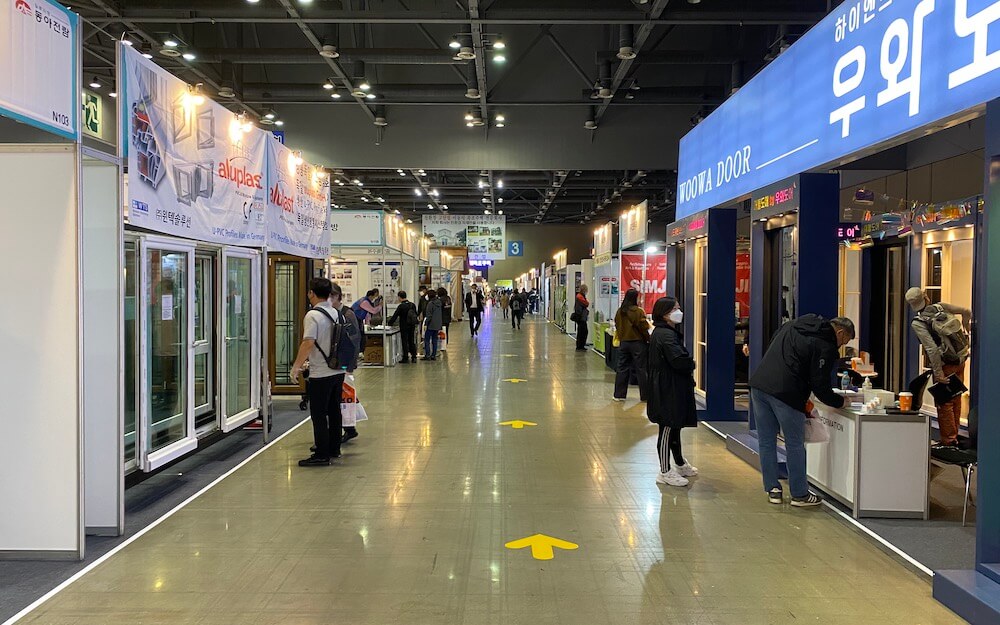
Attendee traffic was routed in one direction only at the MBC Architecture Show, held May 10-13 at KINTEX in South Korea.
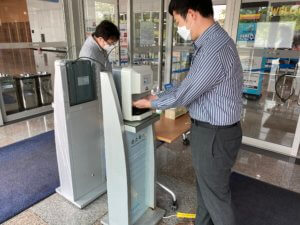
Attendees at the MBC Architecture Show wear masks as they sanitize their hands before entry. Those steps were just part of the safety protocols at the event.
The first large trade shows to be held in the Asia Pacific region since the coronavirus pandemic created mass cancellations, which were held this week or have recently concluded, offer a look at the kinds of protocols for health screening, social distancing, and sanitation that meet government requirements and attempt to put attendees at ease. Masks, gloves, hand sanitizers, acrylic barriers, mandatory distancing, frequent disinfection of the venues, and other precautions were prominent features of two large shows, the 2020 Hunan Auto Show, held in Changsha, China, and the MBC Architecture Expo, held in Goyang, South Korea.
The 2020 Hunan Auto Show, held April 20 to May 5, brought 62,380 visitors at the Hunan International Convention and Exhibition Center, in Changsa, China. As reported by The Tradeshow Executive, here were the measures that were taken:
- Attendees had to submit an ID card and undergo a strict health and identity check prior to arriving at the venue. Once approved, they were issued a digital link that they could use to register for the event via WeChat.
- Workers in full protective gear checked and verified each visitor’s ID and temperature each time they entered the exhibition hall. Attendees had their hands disinfected by an automatic machine and were given plastic gloves to wear and were instructed to stay 1.5 meters (approximately 5 feet) away from each other.
- All participants in the exhibition were obligated to wear masks throughout and urged to wash hands frequently.
- Registration was capped at 8,000 attendees daily, and once registration reached 4,000 each day, the platform was paused to assess the density of participants, before it was started again.
- The convention center was disinfected twice a day, and fresh outdoor air was pumped into the convention center through the fresh-air system.
- Two temporary medical centers were built and set up at the site — one outside the building and one on the show floor.
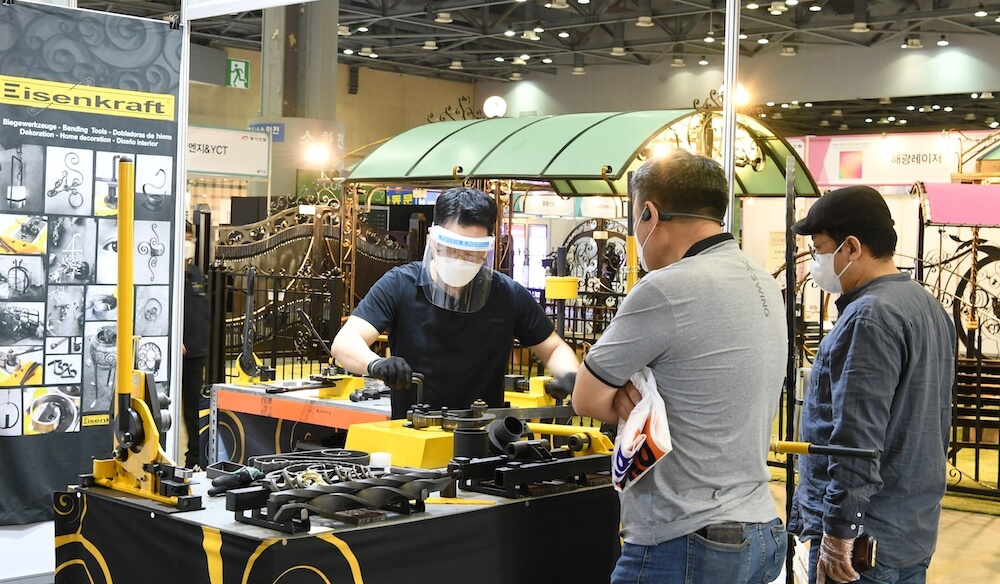
An exhibitor shows attendees products at the MBC Architecture Show. All exhibitors at the May event in South Korea were required to wear face shields.
The MBC Architecture Show was held May 10–13 at the Korean Exhibition Center, (KINTEX), in Goyang, South Korea, with 45,400 in attendance. Frank Yang, PMP, CMP, CEM, director of Frank has a accountconvention marketing and business development at KINTEX, detailed the following protocols in an article on LinkedIn:
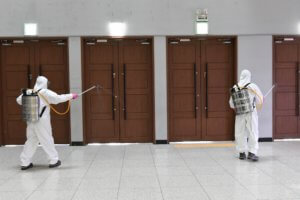
Workers disinfect doors during the MBC Architecture Show at KINTEX in South Korea. Interior spaces were disinfected multiple times a day.
- Thermal imaging cameras and facial recognition thermometers were installed at entrances, along with hand sanitizer dispensers and disinfection mats.
- At the hall entrance, attendees’ temperatures were monitored by a non-contact thermometer.
- When further investigation into attendee health status was needed, individuals were immediately transferred to a containment area.
- Gloves and hand sanitizer were required for admission.
- Emergency room and medical staffs were on standby.
- In the lobby, people waited in line to enter at one-and-a-half meter intervals, marked on the floor.
- Quarantine and disinfection work was conducted once and twice a day, with 100-percent external air intake and air conditioning.
- All visitors were required to wear masks and plastic gloves and exhibitors were required to wear face shields that covered the entire face.
- Those who didn’t follow the above rules were removed by patrol officers.
- Acrylic barriers were placed on tables of the business meeting area and cafeteria.
- Booths were at least four meters apart.
- A videoconference facility was made available for exhibitors.
- Ambulances were on standby to transfer “patients under investigation” in cooperation with local authorities and nearby hospitals.
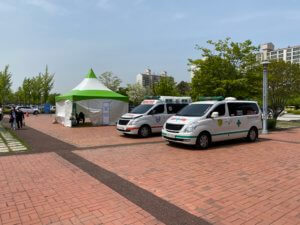
Ambulances and medical teams stand by outside KINTEX during the MBC Architecture Show, held May 10-13, in South Korea.
Yang also posted the following lessons learned from the experience:
The exhibition generated a long admission line and congestion in the lobby because it took so long to put on plastic gloves, apply hand sanitizer, and take attendees’ temperatures, while observing one-and-a-half-meter distances between visitors. To solve this problem, organizers added more personnel, and opened an empty exhibition hall so they could place the admission line inside the hall.
Each visitor had to register on site, even though they were pre-registered. Organizers added four more registration booths and recorded the visitors’ admission date and time for tracking purposes.
Barbara Palmer is deputy editor of Convene.
